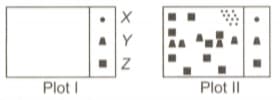Anil Ahlawat Solutions for Chapter: Reproduction in Plants, Exercise 1: EXERCISES
Anil Ahlawat Science Solutions for Exercise - Anil Ahlawat Solutions for Chapter: Reproduction in Plants, Exercise 1: EXERCISES
Attempt the free practice questions on Chapter 11: Reproduction in Plants, Exercise 1: EXERCISES with hints and solutions to strengthen your understanding. NSO Science Olympiad Workbook Grade 7 solutions are prepared by Experienced Embibe Experts.
Questions from Anil Ahlawat Solutions for Chapter: Reproduction in Plants, Exercise 1: EXERCISES with Hints & Solutions
Refer to the given flow chart and select the option which correctly identifies X, Y and Z.

| X | Y | Z | |
| (A) | Moss | Bryophyllum | Maize |
| (B) | Moss | Pineapple | Begonia |
| (C) | Bryophyllum | Begonia | Moss |
| (D) | Moss | Papaya | Pineapple |
Read the given statements (i-iv) with one or two blanks and select the option that correctly fills any two of the statements.
(i) In grafting, a cutting having buds from one plant called the ________ is kept over the stem with roots of another plant called the ________.
(ii) Unorganised mass of the cells in the tissue culture is called ________.
(iii) The shoot forming part of embryo is called ________, while the root forming part of embryo is called________.
(iv) The process of fusion of male gamete with the female gamete to form a zygote is called ________.
Study the given diagrams showing the cross-section of two flowers. Which of the following statements is/are incorrect regarding them?

(i) Plants of these flowers have developed from seeds.
(ii) Flower X is a female flower and flower Y is a bisexual flower.
(iii) Fertilisation can take place in both flowers.
Refer to the given dichotomous key and select the correct statement.
(i) (a) Single parent is involved in reproduction- Go to (ii)
(b) Two parents are involved in reproduction- Go to (v)
(ii) (a) New plants are produced by natural method- Go to (iii)
(b) New plants are produced by artificial method- Go to (iv)
(iii) (a) Plant produced through the stem– P
(b) Plant produced through root- Q
(iv) (a) Plant produced from unorganised cell mass– R
(b) Plant produced by bending young branch towards the ground and covered with moist soil- S
(v) (a) Plant produced when pollen grains are transferred to the stigma of same flower of the same plant- T
(b) Plant produced on transferring pollen grains to the stigma of different flower- U
Ruchi collected four different kinds of seeds (W, X, Y and Z). The characteristic of each seed is given. Identify the seeds and the agent of their dispersal and select the correct option.
W- Surrounded by tiny hair
X- Thick coat of fibres
Y- Presence of hooks or spines
Z- Enclosed in a fruit that bursts open when mature
| Seed | Agent | |
| (A) | W- Dandelion | Animals |
| (B) | X- Coconut | Water |
| (C) | Y- Xanthium | Air |
| (D) | Z- Lotus | Explosion |
Refer to the given figure showing three parent species, X, Y and Z (in plot I) and their respective seedlings after dispersal (in plot II).

Select the incorrect statement regarding species X, Y and Z.
(i) X could be pea plant in which fruits burst open forcibly after drying.
(ii) Y could be Xanthium in which seeds are hooked i.e., have spines.
(iii) Z could be Acer in which fruits and seeds have wings or hair like structure.
(iv) X could be coconut, Y could be lotus and Z could be Calotropis.
The following investigation was carried out using flower buds growing on three plants of the same species:
Plant 1 - The anthers were carefully removed and the buds left open to the air.
Plant 2 - The anthers were left untouched and a paper bag was tied tightly around each bud.
Plant 3 - The anthers were carefully removed and a paper bag was tied tightly around each bud.
All flowers were opened normally but only those on plant 1 produced seeds.
What can be inferred from it?
Refer to the given figure and select the correct statement(s).

(i) The part labelled as P gives rise to fruit.
(ii) The part labelled as R is responsible for transfer of female gamete.
(iii) The part labelled as Q transforms into endosperm.
(iv) The part labelled as Q is a female gamete.
(v) The part labelled as R carries pollen.
